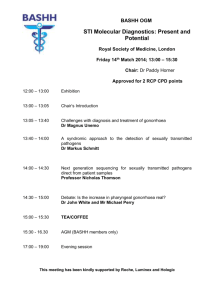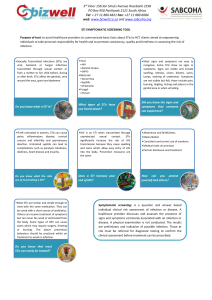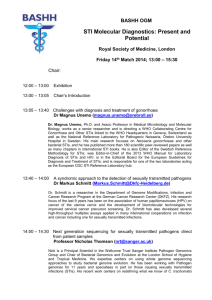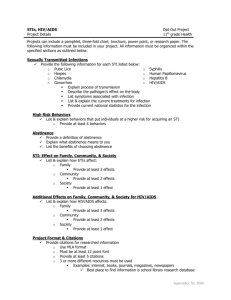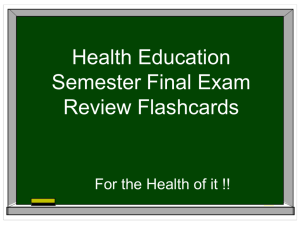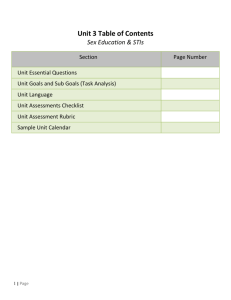Lesson 5: Sexually Transmitted Infections and HIV/AIDS
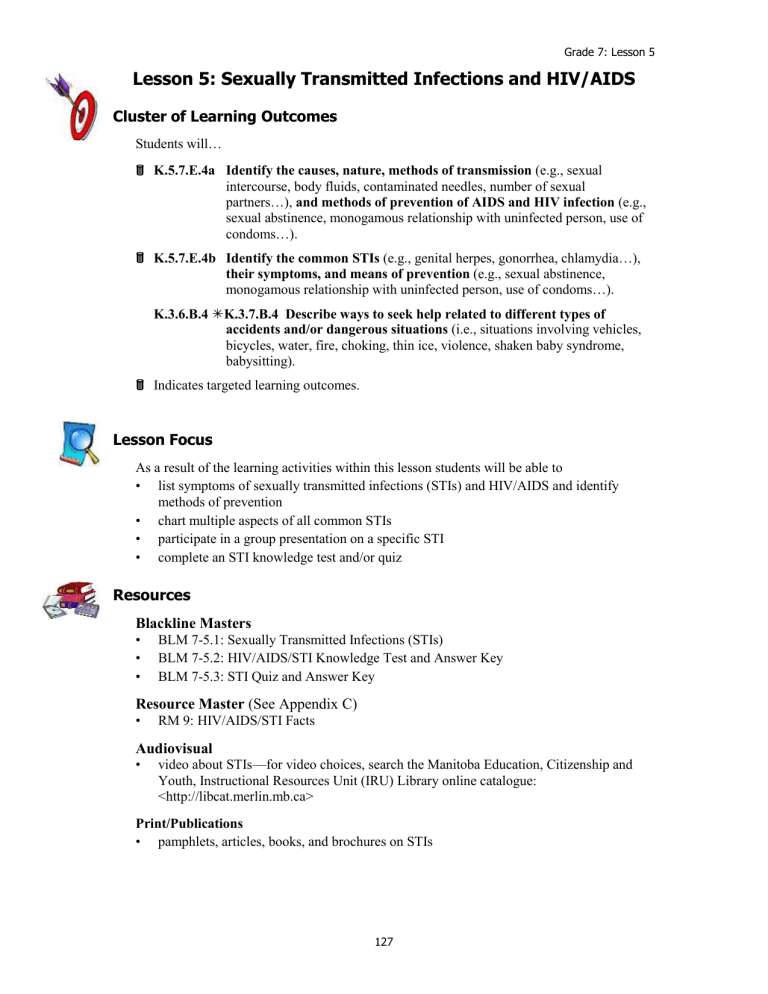
Grade 7: Lesson 5
Lesson 5: Sexually Transmitted Infections and HIV/AIDS
Cluster of Learning Outcomes
Students will…
(e.g., sexual intercourse, body fluids, contaminated needles, number of sexual partners…), and methods of prevention of AIDS and HIV infection (e.g., sexual abstinence, monogamous relationship with uninfected person, use of condoms…).
(e.g., genital herpes, gonorrhea, chlamydia…), their symptoms, and means of prevention (e.g., sexual abstinence, monogamous relationship with uninfected person, use of condoms…).
K.3.6.B.4 K.3.7.B.4 Describe ways to seek help related to different types of accidents and/or dangerous situations (i.e., situations involving vehicles, bicycles, water, fire, choking, thin ice, violence, shaken baby syndrome, babysitting).
Lesson Focus
As a result of the learning activities within this lesson students will be able to
• list symptoms of sexually transmitted infections (STIs) and HIV/AIDS and identify methods of prevention
• chart multiple aspects of all common STIs
• participate in a group presentation on a specific STI
• complete an STI knowledge test and/or quiz
Resources
Blackline Masters
• BLM 7-5.1: Sexually Transmitted Infections (STIs)
• BLM 7-5.2: HIV/AIDS/STI Knowledge Test and Answer Key
• BLM 7-5.3: STI Quiz and Answer Key
Resource Master (See Appendix C)
• RM 9: HIV/AIDS/STI Facts
Audiovisual
• video about STIs—for video choices, search the Manitoba Education, Citizenship and
Youth, Instructional Resources Unit (IRU) Library online catalogue:
<http://libcat.merlin.mb.ca>
Print/Publications
• pamphlets, articles, books, and brochures on STIs
127
Grade 7: Lesson 5
Organizations/Websites
• Canadian Public Health Association (CPHA), Canadian HIV/AIDS Information
Centre/Clearinghouse: <http://www.clearinghouse.cpha.ca/>
• Klinic Community Health Centre: <http://www.klinic.mb.ca/>
• Nine Circles Community Health Centre (NCCHC): <http://www.ninecircles.ca/>
• Sexuality Education Resource Centre (SERC), Manitoba: <http://www.serc.mb.ca/>
Professionals
• local public health nurse or community health centre
Notes to Teacher
Sexually Transmitted Infections (STIs)
If possible, take students to a health clinic that deals with STIs so that they know where it is and would feel more comfortable accessing the services on their own if they should ever have the need.
Community Link:
Have students explore local health issues and prevention strategies, examining statistical data, supports, and services applicable to their community or region.
Symptoms of STIs:
The symptoms of STIs include the following (Evans, Wackett, and Turner 1):
• discharge from the penis
• different or heavier discharge from the vagina
• a burning feeling when urinating
• sores, particularly around the genital or anal areas
• itching feeling around sex organs or anus
• swollen glands in the groin
It is common for people with an STI not to notice any symptoms at all.
Transmission of STIs:
There are many different STIs, and they may be transmitted/contracted in various ways through unprotected contact with body fluids (Evans, Wackett, and Turner 2):
1. Those who have one or more STIs may give the infection to others
— if they touch in certain parts of the body and there is an exchange of body fluid (e.g., saliva, mucus, sperm, semen, vaginal secretion, blood)
— if dry skin-to-skin contact between genitals, mouth, or anus occurs
2. Those who share drug-injection needles, drug equipment, tattooing devices (including ink), and body-piercing devices with someone who has certain STIs may get infected.
3. A female who has certain STIs may infect the fetus during pregnancy, when the baby is being delivered, or while breast-feeding.
Prevention of STI Transmission:
Preventing the spread of STIs could mean the difference between life and death. Teens can reduce their chance of contracting STIs by postponing sexual involvement. Those who choose to become sexually active can reduce their chance by using certain “safer sex” practices (e.g., use of condoms). Abstinence is the only 100% method of preventing the transmission of STIs. Other behaviours such as reducing the number of lifetime sex partners and getting regular STI testing (if sexually active) are also protective.
128
Grade 7: Lesson 5
Curricular Connections
ELA:
GLO 1—Explore thoughts, ideas, feelings, and experiences
GLO 3—Manage ideas and information
GLO 4—Enhance the clarity and artistry of communication
GLO 5—Celebrate and build community
Family Involvement
• Invite parents into the classroom for the presentations on STIs.
Suggestions for Instruction
1. Have students generate a list of common STIs. Record student responses on the classroom board.
2. Get the Facts First: Have students visit a health clinic for a presentation on STIs from a health care provider. If a clinic visit cannot be arranged, invite the health care provider to the class to speak to students. (Showing a video would be an alternative.) Ask students to keep a list of symptoms of STIs and ways to prevent transmitting STIs.
Common STIs:
• chlamydia
• genital herpes
• genital warts
• gonorrhea
• hepatitis B
• HIV/AIDS
• human papilloma virus (HPV)
• pubic lice
• syphilis
• vaginitis
3. Chart It: Provide or have students bring to class a variety of resources on STIs (e.g., brochures, pamphlets, books, articles). Arrange students in groups of four, and have each group fill in a chart of facts about STIs, including the following headings:
• Name of Infection
• Causes
• Symptoms
• Transmission and Communicability
• Prevention
Have each group join another group to amalgamate the facts, and then discuss all the information as a class.
Refer to BLM 7-5.1: Sexually Transmitted Infections (STIs).
129
Grade 7: Lesson 5
4. Sexually Transmitted Infection Report: Have groups of students research and display information on one of the STIs. Have each group prepare a five- to ten-minute presentation (report) to share information about symptoms, transmission, and prevention methods related to a specific STI.
5. To assess student knowledge of HIV/AIDS/STIs, have them complete a test or quiz.
Discuss the answers as students correct their own tests/quizzes.
Refer to BLM 7-5.2: HIV/AIDS/STI Knowledge Test and Answer Key and
BLM 7-5.3: STI Quiz and Answer Key.
Also refer to RM 9: HIV/AIDS/STI Facts.
Suggestions for Assessment
Journal/Learning Log
Teacher Assessment: Anecdotal Notes
Have students write an entry (in their Grade 7 Journal/Learning Log ), recording their thoughts and feelings about the issues explored in class.
Suggested Criterion:
Look for evidence of the student’s ability to recognize symptoms of STIs and methods of prevention.
Paper and Pencil Task: Get the Facts First
Teacher Assessment: Inventory
For a presentation on STIs, have students write an
• Admit Slip with a question related to STIs to ask the health care provider
• Exit Slip with a question or comment dealing with the presentation
For information about Admit and Exit Slips, see Success for All Learners (Manitoba
Education and Training 6.60-6.61).
130

